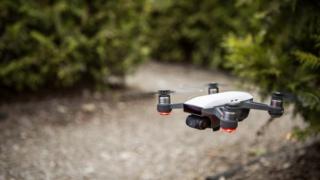DJI Makes Drone Safety Improvements
 Image copyright
DJI
Image copyright
DJI
Drone-maker DJI is improving the technology that prevents them being flown near airports.
The changes come after drones disrupted flights from the UK's Gatwick airport in December.
A more sophisticated geo-fencing system will create a 3D no-go zone surrounding runway flight paths and other sensitive facilities.
This improves on the simple circular structures previously used to block such areas.
The new system will apply in the 13 European countries covered by DJI's original geo-fencing system and 19 countries that previously did not have the safeguards.
The system better reflected the actual safety risks posed near airports as well as allowing more flexibility to fly drones in nearby areas, the company said.
Temporary flight restrictions will also be included in the revamp, which can be imposed during major events or natural disasters.
DJI's head of policy, Christian Struwe, said: "DJI is eager to ensure that safety remains the top priority as the European drone industry innovates new ways to use drones in exciting and productive ways.
"Introducing state-of-the-art safety features in even more countries will help the general public and drone operators alike."
He added: "European airspace management must accommodate advanced future operations, such as automated flight and flight beyond the operator's line of sight, without imposing new burdens on recreational and professional drone pilots who have completed millions of safe and beneficial flights."
The changes will be phased in from later this month and customers should update their flight control app and the aircraft software in order to receive the updates.
The no-fly zones for airports were first created by DJI in 2013, with geo-fencing introduced in 2016. It has since added no-fly zones for prisons and nuclear power plants.
The system uses GPS and other navigational satellite signals to prevent drones from flying near these sensitive locations or high-profile events.
The new technology was developed by UK firm, Altitude Angel.
From Chip War To Cloud War: The Next Frontier In Global Tech Competition
The global chip war, characterized by intense competition among nations and corporations for supremacy in semiconductor ... Read more
The High Stakes Of Tech Regulation: Security Risks And Market Dynamics
The influence of tech giants in the global economy continues to grow, raising crucial questions about how to balance sec... Read more
The Tyranny Of Instagram Interiors: Why It's Time To Break Free From Algorithm-Driven Aesthetics
Instagram has become a dominant force in shaping interior design trends, offering a seemingly endless stream of inspirat... Read more
The Data Crunch In AI: Strategies For Sustainability
Exploring solutions to the imminent exhaustion of internet data for AI training.As the artificial intelligence (AI) indu... Read more
Google Abandons Four-Year Effort To Remove Cookies From Chrome Browser
After four years of dedicated effort, Google has decided to abandon its plan to remove third-party cookies from its Chro... Read more
LinkedIn Embraces AI And Gamification To Drive User Engagement And Revenue
In an effort to tackle slowing revenue growth and enhance user engagement, LinkedIn is turning to artificial intelligenc... Read more

